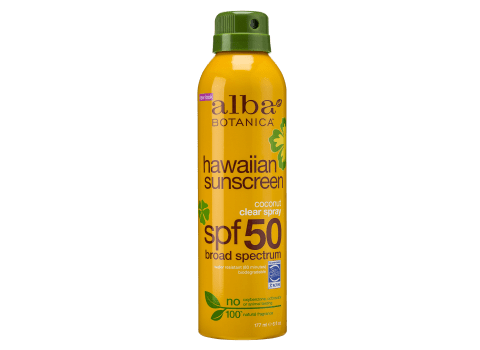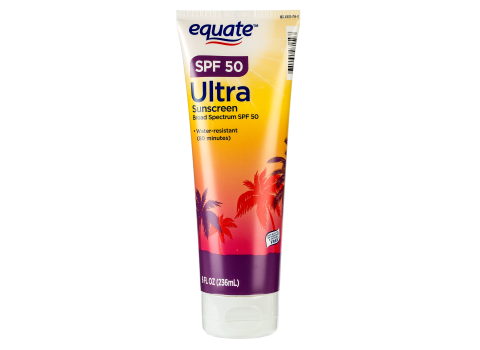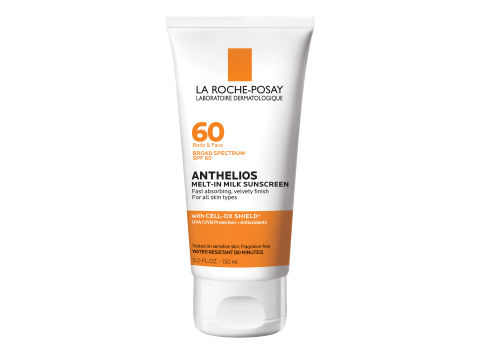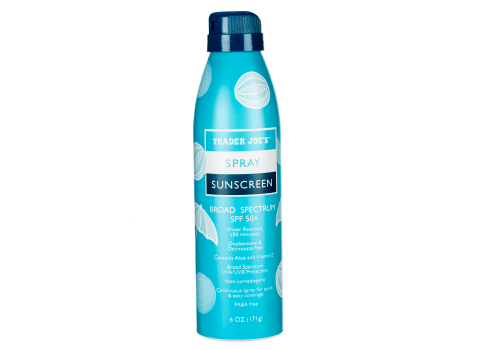The Truth About 'Reef Safe' Sunscreen
Labels don't tell the whole story. Here’s how to protect your skin—and the environment.

By Sally Wadyka
Several years ago, scientists started to raise the alarm about the potential harm sunscreen might have on coral reefs and other marine life. That has led to more research, bans on certain sunscreen ingredients in some locations (such as Hawaii and the U.S. Virgin Islands), and a proliferation of sun-care products on store shelves that manufacturers claim are “reef safe” or “reef friendly.”
But just what “reef safe” means is unclear, and the science about the possible threat that sunscreen poses to the environment is far from settled. “This is an evolving—and confusing—field scientifically, and a lot of the current information is contradictory,” says Michael Gonsior, PhD, an associate professor at the University of Maryland Center for Environmental Science. “The problem at the moment is that we have concerned consumers, but the scientific evidence is not there yet to properly evaluate sunscreen’s impact.”
A new report from the nonprofit, independent National Academies of Sciences, Engineering, and Medicine outlines the challenges in determining the effect of the ultraviolet filters in sunscreen and other personal care products on freshwater environments and oceans and the plants, animals, and other organisms that live there. “There are many gaps in our understanding of the fate, distribution, and toxicity of the UV filters themselves, and especially when used together and in the face of other stressors on the environment, such as climate change,” says Mark S. Cullen, MD, vice chair of the committee that produced the report and former director of the Center for Population Health Sciences at Stanford University.
The compounds are very different, he notes, and “things that can be learned about one do not necessarily carry over to another.” The benefits these UV filters provide in terms of sunburn and skin cancer protection have to be considered as well. “If one or more [UV filters] were to be removed from use for reasons of concerns about the environment, its impact would potentially disrupt the availability of broad-spectrum UV coverage, because most of the current products that are marketed use more than one of the UV filters,” Cullen says.
The report recommends that the Environmental Protection Agency do an ecological risk assessment of UV filters and that the need for such an assessment is urgent. “Risk assessment is largely about the potential that chemicals may be harmful, and the closer that exposure levels [of a substance] get to effects levels, you get the increased likelihood that there could be an ecological risk,” says Charles A. Menzie, PhD, chair of the report committee and a principal at Exponent, an engineering and scientific consulting firm. “What we saw was that effects of levels were such that they were encroaching upon levels in which you see some of the higher exposures in certain types of environments.” He says that given the lack of knowledge of some of the aspects of effects and exposure of UV filters, “there is reason to urge the EPA to take a more formal look at this and address information gaps to understand things better.”
For now, though, that leaves consumers who are equally concerned about protecting their skin and the environment with some tricky choices and no definitive answer to the question of what’s safe. Here’s what we do (and don’t) know about sunscreen and marine life.
Sunscreen’s Environmental Toll
Over the past decade or so, many researchers have studied the possible impact of sunscreen ingredients on coral reefs, aquatic plants, fish, and other marine life. This body of research—while still not definitive—has raised concerns that some sunscreen ingredients may be causing harm.
Several studies have shown that two common ultraviolet filters—oxybenzone and octinoxate—may have the most detrimental effects. They’re part of a group of chemical active ingredients in sunscreen, meaning they protect skin by absorbing the sun’s ultraviolet rays and then dissipating the energy. For example, a 2016 study published in the journal Archives of Environmental Contamination and Toxicology was one of the first to raise concerns. It found that baby coral exposed to oxybenzone exhibited signs of distress, including coral bleaching, a condition that leaves coral vulnerable to infection and prevents it from getting the nutrients it needs to survive. Coral also had DNA damage and abnormalities in its growth and skeleton.
“Oxybenzone, which is just one of the sunscreen contaminants, has a major toxicological effect on plants and algae,” says Craig Downs, PhD, executive director of the nonprofit Haereticus Environmental Laboratory and an author of the study. “Seagrass and algae are critical habitats and food for coral reef fish and other marine life,” he says. “Damage to those plants puts more stress on the animals that depend on them.” Downs has also done research showing that the sunscreen ingredient octocrylene may generate the chemical benzophenone, a compound that’s a carcinogen and may have hormone-disrupting effects. “Octocrylene is bad for fish, corals, and other invertebrates.”
Sunscreen in the Lab vs. Sunscreen in the Ocean
But a majority of the research looking at the harmful effects of sunscreen ingredients on coral reefs and other aquatic organisms has been done in a lab, and lab studies can tell only part of the story.
In these settings, corals are exposed to high levels of sunscreen chemicals to see how it affects them. “A lot of those studies report toxicity, but the real question is whether the organisms are being exposed to a level of that chemical they would ever see in the environment,” says Timothy Bargar, PhD, an ecotoxicologist at the U.S. Geological Survey’s Wetland and Aquatic Research Center. Field researchers generally find much lower levels of chemicals in the water than what is used in laboratory settings. “Even in areas popular with swimmers, and with the highest concentrations of sunscreen chemicals, the levels of those chemicals in the water, on average, are still quite a bit lower than those reported in the majority of studies to be toxic to marine life.”
In some cases, studies that show that oxybenzone can kill coral use concentrations that are 1,000 times higher than what you’d find in a natural environment, according to Gonsior. “That’s not to say that lower concentrations have no effect,” he says. “There may be harmful effects from chronic exposure at lower levels.”
While it’s easy to tag certain sunscreen ingredients as the cause of all the harm to coral reefs, they are only one part of a larger issue. “There are a multitude of stressors on coral reefs,” Gonsior says. “UV filters are part of the mixture, but to isolate them out as the only cause isn’t fair.”
In addition to sunscreen chemicals, scientists have identified several potential factors leading to coral reef damage, including elevated sea surface temperature and sewage and wastewater entering the ocean.
What Does 'Reef Safe' Really Mean?
There’s no standard or regulated meaning behind “reef safe” or “reef friendly.” Some sunscreens with those claims don’t contain oxybenzone or octinoxate. Others include only minerals (titanium dioxide and zinc oxide) or contain a mix of mineral and chemical ingredients. “The definition of what the manufacturer might mean by ‘reef safe’ and similar terms keeps broadening,” says Henry W. Lim, MD, a dermatologist at the Henry Ford Medical Center in Detroit.
Relying on them can also give you a false sense of security. “We don’t know if products labeled ‘reef safe’ really are better for the environment or not,” Gonsior says. “It’s really just a sales gimmick at the moment.” He points out that too much is still unknown about the possible effects of the many different sunscreen ingredients, alone and in combination. In fact, while many “reef safe” sunscreens contain only mineral ingredients, a 2014 study found that titanium dioxide in the water produced hydrogen peroxide, a chemical that’s harmful to marine organisms.
Unanswered Questions
Most experts agree that the effect of sunscreen on the environment is still a gray area and that more research needs to be done to find definitive answers.
A 2021 review, published in the journal Environmental Toxicology and Chemistry, analyzed data from 12 studies of sunscreen ingredients and their effect on coral. The researchers concluded that while there’s ample proof that UV filters are found in ocean waters, there’s limited evidence that their presence is causing significant harm to coral reefs.
Yet, they said, it would be “premature to conclude that . . . UV filters do not adversely impact coral reefs.” The authors of this review—and other researchers—are calling for more studies that evaluate the toxicity of sunscreen ingredients in real-world settings. “We need to know not just what concentrations cause harm to corals in a lab, but what the effects are at environmentally realistic levels,” Bargar says.
Protecting Your Skin and the Ocean
While we wait for science to gather more precise data, the solution isn’t to ignore the potential harm to oceans or to skip sunscreen. Instead, you can find a balance that will shield your skin and possibly help the environment.
The first thing is “to recognize that sun protection is a total package,” Lim says. “Seek shade and wear sun-protective clothing, and only use sunscreen on exposed skin.”
Wearing a high-necked, long-sleeve rash guard instead of just a bathing suit can significantly cut down on the amount of sunscreen you need to use on your body—and the amount that ultimately ends up in the water. “From an environmental perspective,” Downs says, that’s a “massive victory.”
Until we know more, we can’t say for sure which sunscreen ingredients truly are “reef safe,” but given that as of now, oxybenzone and octinoxate are the ones raising the most environmental concerns (and are part of some sunscreen bans), you may want to consider avoiding products that contain them. In recent years, many sunscreen manufacturers have stopped using oxybenzone and octinoxate in their products, so finding a sunscreen without them is getting easier. None of the recommended sunscreens in CR’s ratings contain oxybenzone or octinoxate.
If you decide to use a mineral sunscreen, know that in CR’s tests over the years, they have consistently performed less well than those that contain chemical active ingredients. Our testing found that California Kids #supersensitive Tinted Lotion SPF 30+ and Badger Active Natural Mineral Cream Unscented SPF 30 provide the best overall protection of the mineral sunscreens in our tests, although they aren’t among the top performers.
Top Sunscreens From Consumer Reports' Tests
The following sunscreens performed well in CR’s tests for SPF and UVA protection and don’t contain oxybenzone or octinoxate.
Alba Botanica Hawaiian Coconut Clear Spray SPF 50

Equate (Walmart) Ultra Lotion SPF 50

La Roche-Posay Anthelios Melt-In Milk Lotion SPF 60

Trader Joe's Spray SPF 50+

Best Mineral Sunscreens From Consumer Reports' Tests
These products provide the best overall protection of the mineral sunscreens in our tests, although they aren’t among the top performers.
Badger Active Mineral Cream SPF 30 Unscented

California Kids #supersensitive Tinted Lotion SPF 30+

Editor’s Note: This article has been updated to include information on the National Academies report. It was originally published July 10, 2018.
More from Consumer Reports:
Top pick tires for 2016
Best used cars for $25,000 and less
7 best mattresses for couples
Consumer Reports is an independent, nonprofit organization that works side by side with consumers to create a fairer, safer, and healthier world. CR does not endorse products or services, and does not accept advertising. Copyright © 2022, Consumer Reports, Inc.

